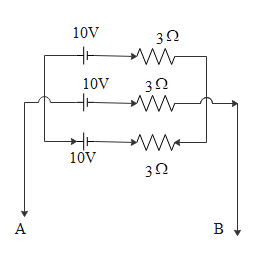
Three identical cells are connected in parallel across AB. Net emf across AB is


Answer
502.2k+ views
Hint: Given three identical cells connected in parallel having each internal resistance of 3 ohm. When we connect the voltage sources having the same emf which are connected in parallel and then each one is connected to the load resistance. Then the total emf will be the same as that of individual emfs.
Complete step-by-step solution:
Generally with n batteries ${{\varepsilon }_{i}}$with internal resistances ${{R}_{i}}$ is connected in parallel. Then we can calculate the equivalent emf using the equation,
${{\varepsilon }_{eq}}=\dfrac{\dfrac{{{\varepsilon }_{1}}}{{{R}_{1}}}+\dfrac{{{\varepsilon }_{2}}}{{{R}_{2}}}+\dfrac{{{\varepsilon }_{3}}}{{{R}_{3}}}+.........+\dfrac{{{\varepsilon }_{n}}}{{{R}_{n}}}}{\dfrac{1}{{{R}_{1}}}+\dfrac{1}{{{R}_{2}}}+\dfrac{1}{{{R}_{3}}}+........+\dfrac{1}{{{R}_{n}}}}$
Here we have three sources of emfs and three resistance which are connected in parallel. Hence the equation becomes,
${{\varepsilon }_{eq}}=\dfrac{\dfrac{{{\varepsilon }_{1}}}{{{R}_{1}}}+\dfrac{{{\varepsilon }_{2}}}{{{R}_{2}}}+\dfrac{{{\varepsilon }_{3}}}{{{R}_{3}}}}{\dfrac{1}{{{R}_{1}}}+\dfrac{1}{{{R}_{2}}}+\dfrac{1}{{{R}_{3}}}}$
Also given that,
${{\varepsilon }_{1}}={{\varepsilon }_{2}}={{\varepsilon }_{3}}=10V$
${{R}_{1}}={{R}_{2}}={{R}_{3}}=3\Omega $
Substituting these values in the above equation we get,
\[{{\varepsilon }_{eq}}=\dfrac{\dfrac{10}{3}+\dfrac{10}{3}+\dfrac{10}{3}}{\dfrac{1}{3}+\dfrac{1}{3}+\dfrac{1}{3}}\]
Thus we get,
\[\begin{align}
& {{\varepsilon }_{eq}}=\dfrac{30}{3} \\
& \Rightarrow {{\varepsilon }_{eq}}=10V \\
\end{align}\]
Therefore we can say that the equivalent emf in a parallel circuit is equal to the individual emf of the battery.
Note: The houses are wired in parallel and never use series connection because in the case of a parallel circuit the loads can operate with respect to the device we use. Thus we use series connections rare for household wirings. Since in series the total voltage is divided equally among all we will get the required voltage for a particular device. And also when we connect the voltage sources having the same emf which are connected in parallel and then each one is connected to the load resistance. Then the total emf will be the same as that of individual emfs.
Complete step-by-step solution:
Generally with n batteries ${{\varepsilon }_{i}}$with internal resistances ${{R}_{i}}$ is connected in parallel. Then we can calculate the equivalent emf using the equation,
${{\varepsilon }_{eq}}=\dfrac{\dfrac{{{\varepsilon }_{1}}}{{{R}_{1}}}+\dfrac{{{\varepsilon }_{2}}}{{{R}_{2}}}+\dfrac{{{\varepsilon }_{3}}}{{{R}_{3}}}+.........+\dfrac{{{\varepsilon }_{n}}}{{{R}_{n}}}}{\dfrac{1}{{{R}_{1}}}+\dfrac{1}{{{R}_{2}}}+\dfrac{1}{{{R}_{3}}}+........+\dfrac{1}{{{R}_{n}}}}$
Here we have three sources of emfs and three resistance which are connected in parallel. Hence the equation becomes,
${{\varepsilon }_{eq}}=\dfrac{\dfrac{{{\varepsilon }_{1}}}{{{R}_{1}}}+\dfrac{{{\varepsilon }_{2}}}{{{R}_{2}}}+\dfrac{{{\varepsilon }_{3}}}{{{R}_{3}}}}{\dfrac{1}{{{R}_{1}}}+\dfrac{1}{{{R}_{2}}}+\dfrac{1}{{{R}_{3}}}}$
Also given that,
${{\varepsilon }_{1}}={{\varepsilon }_{2}}={{\varepsilon }_{3}}=10V$
${{R}_{1}}={{R}_{2}}={{R}_{3}}=3\Omega $
Substituting these values in the above equation we get,
\[{{\varepsilon }_{eq}}=\dfrac{\dfrac{10}{3}+\dfrac{10}{3}+\dfrac{10}{3}}{\dfrac{1}{3}+\dfrac{1}{3}+\dfrac{1}{3}}\]
Thus we get,
\[\begin{align}
& {{\varepsilon }_{eq}}=\dfrac{30}{3} \\
& \Rightarrow {{\varepsilon }_{eq}}=10V \\
\end{align}\]
Therefore we can say that the equivalent emf in a parallel circuit is equal to the individual emf of the battery.
Note: The houses are wired in parallel and never use series connection because in the case of a parallel circuit the loads can operate with respect to the device we use. Thus we use series connections rare for household wirings. Since in series the total voltage is divided equally among all we will get the required voltage for a particular device. And also when we connect the voltage sources having the same emf which are connected in parallel and then each one is connected to the load resistance. Then the total emf will be the same as that of individual emfs.
Recently Updated Pages
A man running at a speed 5 ms is viewed in the side class 12 physics CBSE

The number of solutions in x in 02pi for which sqrt class 12 maths CBSE

State and explain Hardy Weinbergs Principle class 12 biology CBSE

Write any two methods of preparation of phenol Give class 12 chemistry CBSE

Which of the following statements is wrong a Amnion class 12 biology CBSE

Differentiate between action potential and resting class 12 biology CBSE

Trending doubts
What are the major means of transport Explain each class 12 social science CBSE

Which are the Top 10 Largest Countries of the World?

Draw a labelled sketch of the human eye class 12 physics CBSE

Explain sex determination in humans with line diag class 12 biology CBSE

Explain sex determination in humans with the help of class 12 biology CBSE

Differentiate between homogeneous and heterogeneous class 12 chemistry CBSE




